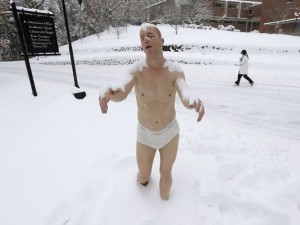The Davis Museum at Wellesley College opened the exhibition Tony Matelli: New Gravity only yesterday, but one particular sculpture is already flying around social media sites and has made the national news. The sculpture, entitled Sleepwalker, is a hyper-realistic portrayal of a man in his underwear with his arms outstretched.
The sculpture was installed on Monday outside the museum, near the road in a high pedestrian and auto traffic area at the all-women campus. Davis Museum Director Lisa Fischman wrote on Wellesley College’s official website: “I love the idea of art escaping the museum and muddling the line between what we expect to be inside (art) and what we expect to be outside (life).”
Almost immediately, a petition was placed on Change.org asking for the sculpture’s removal (which has more than 500 signatures as of this morning). ”[T]his highly lifelike sculpture has, within just a few hours of its outdoor installation, become a source of apprehension, fear, and triggering thoughts regarding sexual assault for many members of our campus community,” says the petition. “While it may appear humorous, or thought-provoking to some, it has already become a source of undue stress for many Wellesley College students, the majority of whom live, study, and work in this space.”
While the director acknowledged that reactions have been “varied,” she also wrote, ”As the best art does, Tony Matelli’s work provokes dialogue, and discourse is at the core of education.” But one of the students who started the petition told The Boston Globe, ”We were really disappointed that she seemed to articulate that she was glad it was starting discussion, but didn’t respond to the fact that it’s making students on campus feel unsafe, which is not appropriate.” She added, “We really feel that if a piece of art makes students feel unsafe, that steps over a line.”
This ruckus comes only a couple of weeks after President Obama announced the creation of a task force to look into sexual assaults on college campuses. The White House Council on Women and Girls released a report that states, among many statistics and proposals, that one in five students has been sexually assaulted, though only 12 percent of them report the violence.
The museum has a Facebook page inviting student discussion on the issue, which varies from enthusiastic support for the artwork, calling detractors humorless, to recounts of sexual abuse apparently triggered by the sculpture. Some simply see the problem as one of context. “I think art’s intention is to confront, but not assault, and people can see this as assaulting,” art history senior Annie Wang told The Globe. While she agreed that the statue forced passers-by to contemplate the nature of art, she also said, “I think place and a context matters, and I don’t think this is the place to put it.”




1 comment
One student wrote—“We really feel that if a piece of art makes students feel unsafe, that steps over a line.” Really? It is a piece of art, a hunk of urethane resin in the shape of a guy in his underwear intended to make someone think. He isn’t brandishing a menacing a knife or hard on. Not to dismiss a young persons phobia’s, which can be very real and not a subject lightly taken, but the same millennial culture will selfie itself into the annals of unsavory behavior and then 180 to voice an objection on someone else’s expressions. I’m asking if the human form in it’s glamorless form is what causes a person to feel unsafe. If the same image of a chisel-cut Abercrombie and Fitch male model showed up in Urethan on the campus I’m wondering if the objection would be as swift with the same report of feeling unsafe. Just askin.